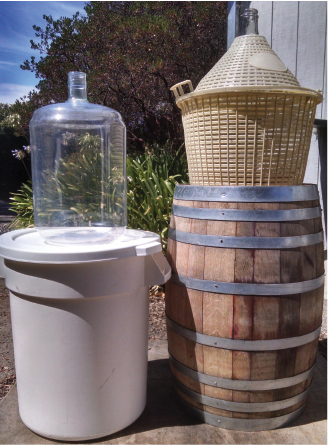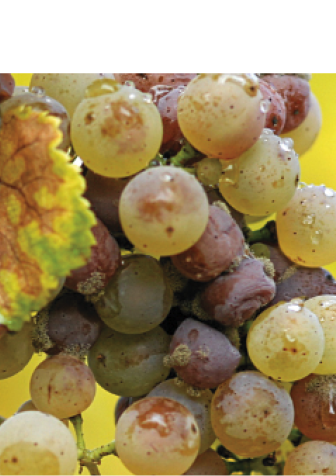
A wine container must be sturdy enough for the purpose and not likely to introduce negative changes to the wine quality. Size is important, depending on the winemaker’s capacity to move heavy containers. Other considerations include cost, convenience, inertness, cleaning, sanitation, and availability.
OAK BARRELS
Oak barrels hold a special place among wine containers. Only wood is chosen to deliberately make changes in the beverage. All other containers are valued for being inert. In the ancient world, clay amphorae were used to store and transport wine. While some Mesopotamian societies used barrels made of palm wood, it is hard to bend and never became widely used. As amphora-using Romans advanced into Northern Europe, they encountered Gauls using oak barrels for beer. Recognizing that oak was pliable enough to bend and its tight grain structure could make water-tight containers, the Romans began using oak barrels for wine. The barrels were lighter and stronger than amphorae and became a major technological advance, leading to the end of commercial amphora use within about 200 years.
Most wine barrels in modern times are made from two species of European white oak (Quercus robur and Quercus sessilis) or a different species of American white oak (Quercus alba). Redwood, red oak, cherry wood, and chestnut are among other woods that can produce sound barrels using standard production techniques. Some of these woods have been found to be either too porous for long-term storage or to be too high in extractives that can contribute unpleasant flavors or aromas to wine. Woods other than white oak do not impart the desirable flavors and aromas that are expected in fine wines. For those flavors and aromas, oak is toasted. To bend barrel staves, they are heated over a fire of oak scraps. Originally just a manufacturing step, this fire-toasting was found to remove raw wood flavors and add mellow notes of vanilla, chocolate, and caramel. In addition to oak flavors, a barrel allows gradual introduction of oxygen to the wine to enhance aging. While commercial wineries can use microoxygenation systems in stainless steel tanks for the same purpose, the oak barrel is the only practical choice for home winemakers seeking this beneficial oxygen transfer.
The larger a barrel, the less wood it needs for each gallon (liter) of wine that is contained. For many years, most barrels were about 30 gallons (114 L)— large enough to be economical but small enough for workers to move full. As mechanized handling came into use, 59.5-gallon (225-L) barrels became more common. The same size ratio applies to aging effects as well; a larger barrel imparts less oak character to the wine in a given time than a smaller barrel. Those near 60 gallons (227 L) strike a good balance between adding oak character and allowing for economical production. For home winemakers these barrels are often too large and are awkward to move around, even when empty. Smaller barrels are easier to move and are readily available in sizes from 1 gallon (4 L) to 30 gallons (114 L). My long-time colleague and mentor Byron Burch had a rule of thumb for the faster oaking with small barrels: One week per gallon (4 L) of capacity. So when you use a new full-size barrel, you can age for a year or more without over-oaking. In a 5-gallon (19-L) barrel, you only have about 5 weeks before you need to move the wine to an inert container. For home use, sizes from about 15 gallons (57 L) to 30 gallons (114 L) strike a good balance of oaking and utility.
When an oak barrel is manufactured, it is mechanically sound, but has never held liquid. Because it may leak when filled, it must first be swelled up with clean water. This should take only a few hours or can be done overnight. Afterwards, drain out the water, position the barrel on blocks or a rack, and fill with wine. To barrel-ferment a white wine like Chardonnay, leave about 1⁄4 of the barrel capacity as headspace for foaming and fit a fermentation lock. For aging of red or white, top up to the bottom of the bunghole and use a fermentation lock, a silicone breather bung, or a solid bung. I use fermentation locks or breather bungs in my barrels because I am never certain there will be no activity or thermal expansion that might pop out a solid bung. Because there is only a small opening in a barrel, it is not generally suitable as a fermenter for red wine on the skins. A new barrel of about 30 gallons (114 L) will probably cost between $400 and $600. A “recoopered” barrel made from the shaved staves of a used full-size barrel and re-toasted may cost under $400. French oak is generally more expensive than American oak.
Used barrels present additional challenges. If you are buying one, assure yourself that it does not smell of vinegar (volatile acidity) or the barnyard stink of Brettanomyces. To clean it, fill a barrel with a solution of sodium percarbonate for a few hours to overnight. Drain, rinse, and rinse again with a solution of citric acid to neutralize any carbonate residue. Rinse again with clean water and drain thoroughly before filling with wine.
GLASS
Inert materials for fermentation and storage include glass, plastic, and stainless steel. Glass has a long history and remains the foremost container for finished wine. Like barrels, most glass containers have a narrow opening and are not suitable for red wine primary fermentation. Fitted with a fermentation lock, a glass carboy or demijohn is very satisfactory for white wine fermentation and for aging of red or white. Sizes range from 1-gallon (4-L) jugs up to 14-gallon (54-L) demijohns. Neck sizes vary, but rubber stoppers or silicone bungs can be found to fit any narrow-mouth container. For a 1-gallon (4-L) jug, expect to pay just a few dollars, with glass carboy and demijohn prices ranging up to about $70. A good liquid detergent like TDC or a powdered cleaner like Powdered Brewery Wash (PBW) or sodium percarbonate will do a good job of cleaning. Sanitize before use with iodophor (BTF or Iostar) or phosphoric acid (StarSan) sanitizer. Glass is an excellent all-around choice in the home winery with just two significant limitations: Glass containers are heavy and fragile. Handle carefully, avoid handling when wet if you can, and consider setting carboys in plastic milk crates or using purpose-built carboy handles or harnesses to minimize risk of breakage.
PLASTIC
“Plastic” refers to a wide variety of synthetic polymers. Those most commonly found in winemaking are high-density polyethylene (HDPE) and polyethylene terephthalate (PET). For winemaking, HDPE is most often found as buckets or open fermenters (food-grade trash cans). If the specific container has been submitted to the National Sanitation Foundation and approved for food contact, it will bear the logo NSF in a circle. The container may also have the resin identification code “2” with a recycling arrow logo. Choose fermenters with these marks to be sure that you will introduce no contaminants to your fermentation. HDPE, unlike vinyl (PVC) polymers, does not contain plasticizers than can leach out of the container; do not use PVC buckets or bins for wine.
HDPE primary fermenters are available in sizes ranging from 5-gallon (19-L) buckets up to 176-gallon (667-L) fork-liftable bins. Some home winemakers can successfully employ these large bins, about 4 feet x 4 feet and 2 feet deep (1.2 x 1.2 x 0.6 m), commonly referred to as a half-ton bin or by the trade name MacroBin. If the large size and weight are a challenge for your home winery, the middle-sized bins of about 32 to 44 gallons (121 to 167 L) may prove more suitable. The half-ton bin, as implied by the nickname, can be used to ferment about 1,000 lbs. (454 kg) of red must. A 32-gallon (121-L) bin can accommodate about 225 lbs. (102 kg) and the 44-gallon (167-L) bin about 330 lbs. (150 kg). Three or four of these containers can approximate the capacity of a full-size bin, with the additional benefit that they nest in a stack for off-season storage. Some narrow-mouth HDPE containers have also been introduced for fermentation. While safe and inert, there is some concern that HDPE may be somewhat permeable to oxygen, allowing transfer from the air like storage in an oak barrel. As long as the transfer is not excessive, the application should be suitable.
More resistant to oxygen transfer is the other common winemaking plastic, PET. This material is used commercially to make liquor bottles, plastic beer bottles, fiber for clothing, and the mirrored-film called Mylar. For the home winery, PET is generally in the form of carboys from 3 gallons (11 L) to 6.5 gallons (25 L). It has a resin identification code of 1 and the letters PET or PETE. With extensive history of commercial alcoholic beverage containers and good oxygen transfer resistance, PET carboys offer very effective alternatives to glass carboys. Like HDPE, it is manufactured without plasticizers.
Many of the same cleaners and sanitizers that are used for glass may be used for plastic but there are some exceptions. One additional caution here is to be very careful about using brushes on these surfaces as they may scratch. Scratches could allow trapping of spoilage organisms that would be difficult to eradicate with sanitizers. Prices for plastic containers range from around $10 for a food-grade bucket through prices in the $20 to $30 range for PET carboys and up to $500 for a half-ton bin.
STAINLESS STEEL
A cylindrical tank with an inset lid is the most common stainless steel container in home wineries. The lid has a vinyl or rubber gasket and a dedicated air pump to inflate it. Because the lid can be positioned anywhere in the height of the tank, the capacity is variable up to the maximum volume. Most of these tanks are type 304 stainless steel (also known as 18/8), which is sufficiently corrosion-resistant for wine use (but avoid excessive exposure to sulfur dioxide as pitting may occur). (Type 316 is also suitable, but generally more expensive.) Tanks are marked in some way to indicate suitability for food use, such as Italian tanks marked “per alimenti.” Sizes range from 13 gallons (50 L) to 260 gallons (1,000 L) or more. All include a valve near the bottom and some may include other features such as cooling jackets, sight gauges, secondary racking valves, and so forth. Most feature a rather tall and narrow profile making them less than ideal for red wine primary fermentation where a ratio of about 1:1 height to width is preferred.
With the lid in place, they are suitable for white wine fermentation and for any wine aging. Some of the same cleaning and sanitizing products may be used; see the column referenced earlier for specific materials. Tank prices range from about $300 for the smaller sizes to well over $1,000 for large tanks.
So there you have it: Wood, glass, plastic, and stainless steel. White oak is special and really has no peer for its specific contribution to wine quality. For uses other than barrel fermentation and aging, the other three materials compete very effectively. Glass is traditional, completely impervious to oxygen transfer, and quite inert. It is, however, heavy and fragile. Plastic eliminates those problems, but introduces the risk of oxygen transfer and possibly scratching. Plastic is significantly cheaper than glass. Stainless steel containers are lighter than glass for their capacity and are not fragile. Unlike plastic, stainless steel does not scratch easily and as a material it is oxygen-transfer proof (although gaskets and bungs may allow some transfer of air). Stainless steel tanks are limited to larger sizes and they are somewhat expensive. At my house, plastic fermenters, glass demijohns, and one stainless steel tank coexist peacefully. Only you can decide what works best in your winery!






